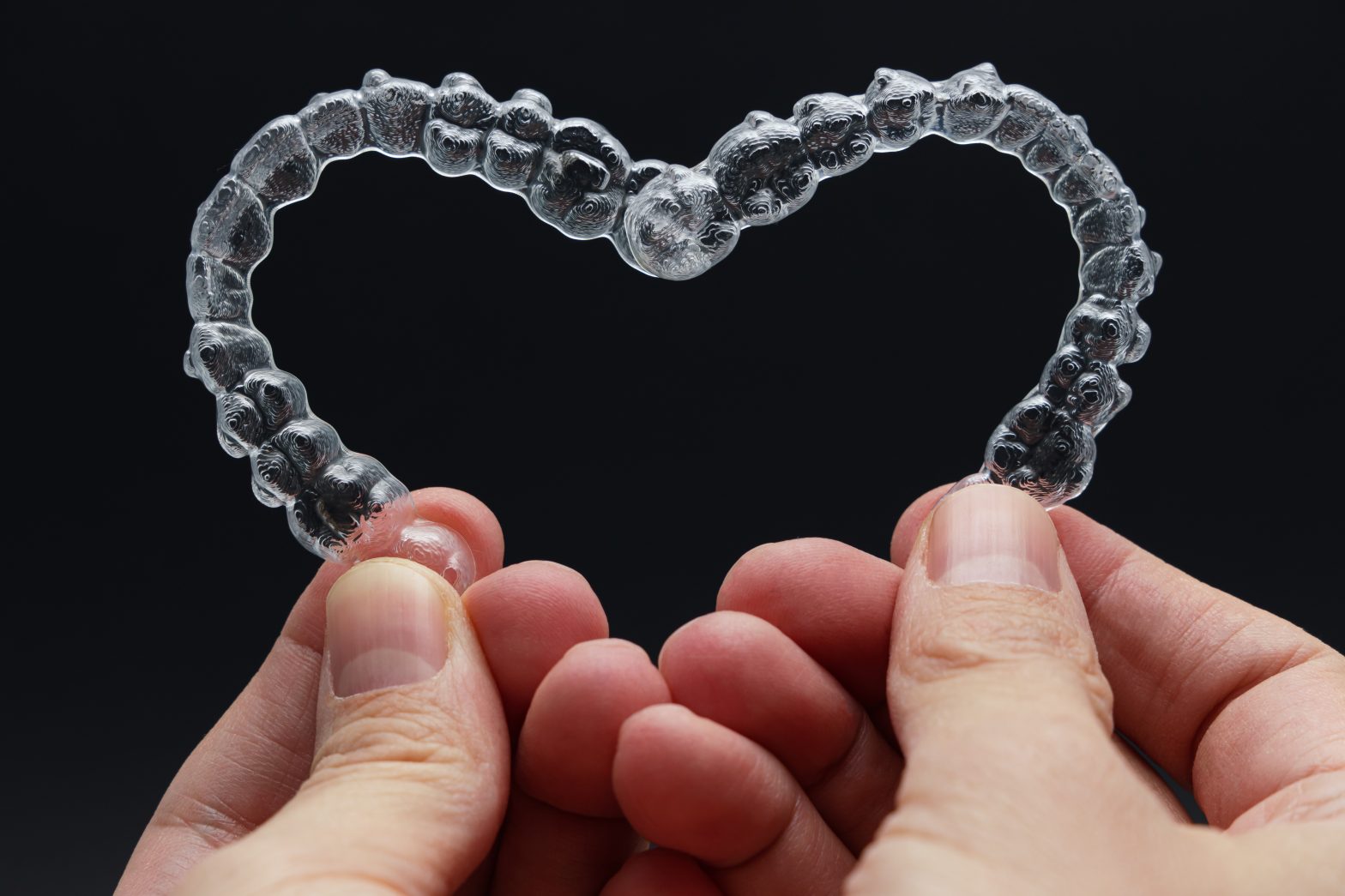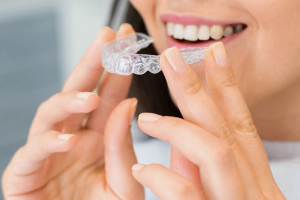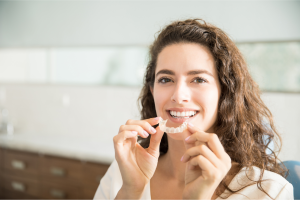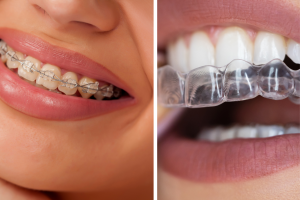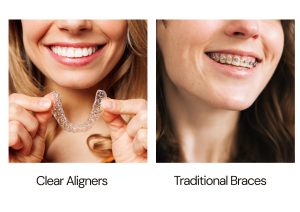Invisible braces—often called clear aligners—offer discreet, removable, digitally planned teeth straightening. This professional guide explains how aligners work, who they suit, treatment timelines, the invisible braces cost in London, and what to expect from start to finish. Internal links throughout help you explore key topics in more detail.
What are invisible braces?
Invisible braces are a sequence of transparent trays custom-made from a 3D scan of your teeth. Each set moves teeth a small, pre-planned amount. Trays are changed on a set schedule until the final position is reached.
Learn the full workflow on How It Works and see our service overview on Clear Aligners in London.
Why patients choose them
- Discreet:Nearly invisible in day-to-day life.
- Removable:Eat and brush normally.
- Planned:Movement mapped digitally for precision and predictability.
Who is suitable for clear aligners?
Clear aligners serve adults and older teens who want controlled movement without fixed brackets. Typical suitability includes:
- Crowding:Overlapping or rotated front teeth, especially the lower incisors.
- Spacing:Gaps (including small diastemas) in the smile line.
- Relapse:Teeth that shifted after earlier orthodontics.
- Selected bite concerns:Mild overbite, some crossbite or open bite, subject to clinical confirmation.
Patients prepared to wear aligners 20–22 hours daily, maintain excellent oral hygiene, and attend short review appointments achieve the most efficient progress. A popular use case at Pro Aligners is clear aligners for mild crowding in London, which often finishes faster with fewer trays than broader bite corrections.
For complex bite changes or large tooth movements, fixed braces can be more efficient. During assessment, our dentist outlines the most appropriate route to a healthy, stable result.
Assessment and planning: what happens first
Clinical consultation & 3D scan
Teeth, gums, bite, and oral health are examined. A digital scan avoids messy impressions.
Digital plan & smile preview
The plan defines tooth movement, projected tray count, and estimated treatment time. A visual preview shows how the smile will change. See the steps on How It Works.
Attachments & IPR (when indicated)
- Attachments:tiny, tooth-coloured shapes placed temporarily to help trays grip and move teeth accurately.
- IPR (Interproximal Reduction):careful polishing between teeth to create micro-space for planned movement.
Both are standard, conservative techniques designed to protect tooth structure and improve predictability.
Daily routine with aligners
Wear schedule
- 20–22 hours per day, removed for meals and for drinking anything other than water.
- Trays are changed on a weekly or fortnightly cadence as prescribed.
Eating & drinking
- Remove trays before hot drinks; heat can distort aligners.
- Minimise staining from coffee, tea, and coloured drinks; rinse and brush before re-insertion.
Oral hygiene
- Brush after meals and floss daily.
- Clean trays with recommended solutions; avoid boiling water and abrasive powders.
Speech, and travel
- A slight lisp can occur for a day or two during adaptation and typically resolves quickly.
- For travel, carry the next set of trays, a spare case, and a compact hygiene kit.
How long does treatment take?
Timelines reflect case complexity and wear consistency:
- Mild crowding or spacing:around 4–8 months
- Moderate cases:around 8–14 months
- More complex goals:longer timelines or a different orthodontic approach
- Refinements—additional trays to finesse the finish—are common and planned as part of modern aligner care.
What results look like
Objectives include straighter front teeth, improved arch form, and easier cleaning around previously crowded areas. Treatment planning prioritises both function and facial aesthetics to maintain a natural appearance. Explore outcomes on Before & After. Results vary; your dentist sets clear expectations at the consultation.
Safety and clinical oversight
Aligner therapy at Pro Aligners is dentist-led from assessment to retention. Movement stays within biological limits, gum health is monitored, and bite relationships are reviewed throughout. Concerns such as sensitivity, attachment visibility, or enamel polishing are explained in plain language during consent and are summarised in our FAQ.
Cost and what to compare in London
Clear aligner pricing varies with case complexity, number of trays, and aftercare. Pro Aligners keeps fees transparent, with pricing from £1,000 and finance options available. .
When researching the invisible braces cost in London, compare like-for-like:
- Clinical consultation and 3D scan
- Planned number of alignersand expected refinement
- Attachments/IPRwhen indicated
- Review appointmentsand emergency support
- Retainers(type and quantity) after treatment
- Optional whitening and aftercare
A clear, itemised package prevents surprises and makes comparisons fair.
Both systems produce excellent results in the right hands. The clinical exam determines the most efficient and healthy route.
Quick suitability checklist
Candidates who see strong outcomes typically share these traits:
- Desire for a discreet, removableorthodontic solution
- Goals centred on front-tooth alignment, crowding, or spacing
- Consistent 20–22 hourdaily wear
- Strong home care and willingness to attend short reviews
- Preference for transparent pricing and a written plan
Those seeking the best clear aligners for adults in London often value minimal lifestyle disruption and digital planning with a doctor-led approach.
Frequently Asked Questions
1) Are invisible braces suitable for adults with mild crowding?
Yes. Clear aligners are well-suited to mild–moderate crowding and spacing. A dentist will confirm clinical suitability during your assessment. Learn more on Clear Aligners in London.
2) How many hours a day should I wear aligners?
Wear aligners 20–22 hours daily. Remove them for meals and for drinking anything other than water. Consistent wear keeps treatment on schedule. See the workflow on How It Works.
3) Will people notice the aligners or attachments?
Aligners are transparent and low-profile. Attachments are small, tooth-coloured shapes placed temporarily to support precise movement; they are usually discreet in normal conversation.
4) Is IPR (interproximal reduction) safe?
IPR is a conservative, planned polishing between teeth to create micro-space. It preserves enamel health when used appropriately and improves predictability.
5) How long does treatment take?
Typical timelines: 4–8 months for mild cases and 8–14 months for moderate cases. Your plan includes an estimated tray count and timeline. Details: How It Works.
6) Can I drink coffee or tea with aligners?
Remove aligners for hot or coloured drinks to avoid warping and staining. Rinse and brush before re-inserting to keep trays clear.
7) What happens if a tray is lost or damaged?
Contact the clinic promptly. Depending on progress, we’ll advise moving to the next tray or stepping back to the previous one. For urgent help: Contact Pro Aligners.
8) Do aligners hurt?
Expect pressure for 24–48 hours after switching to a new tray. This settles quickly. Mild discomfort can be managed with standard analgesics and cool water sips.
9) How much do invisible braces cost in London?
Pricing depends on case complexity, number of trays, and aftercare. Pro Aligners offers transparent packages from £1,000 with 0% finance options. Compare inclusions on Pricing.
10) Will aligners affect speech?
A slight lisp can appear during the first day or two. Most patients adapt quickly as the tongue accommodates the trays.
11) What about oral hygiene and cleaning?
Brush after meals, floss daily, and clean aligners with recommended products. Avoid hot water and abrasive powders.
12) Do I need in-person reviews during treatment?
Yes. Short, scheduled reviews confirm tracking, comfort, and hygiene. Refinements (extra trays) are common to finesse the final result.
Information in this article supports informed decision-making and complements a clinical examination; it does not replace in-person advice from a dentist.
